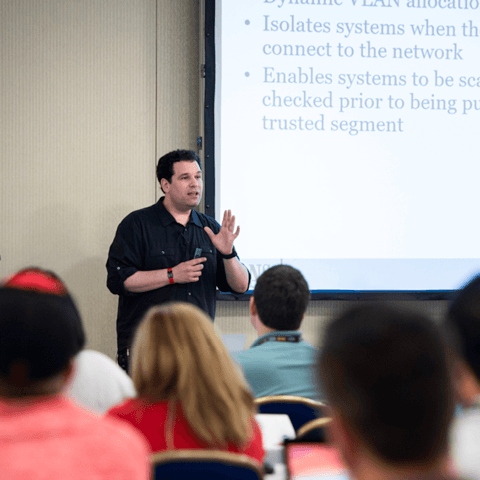SEC595: Applied Data Science and AI/Machine Learning for Cybersecurity Professionals


Experience SANS training through course previews.
Learn MoreLet us help.
Contact usBecome a member for instant access to our free resources.
Sign UpWe're here to help.
Contact Us
Apply your credits to renew your certifications
Attend a live, instructor-led class at a location near you or remotely, or train on your time over 4 months
Course material is geared for cyber security professionals with hands-on experience
Apply what you learn with hands-on exercises and labs
Learn to design enterprise-ready, scalable cloud solutions for your organization. Engage in threat modeling and secure architecture review labs to experience the cloud migration journey.
I would recommend this course. It hits many core aspects of secure design. Additionally, lack of Cloud Security Architecture and Strategy, and Insecure Design have been highlighted as a top risk by organizations like Cloud Security Alliance and OWASP. Cloud security architecture topics need to have more attention and focus in general.
SEC549 prepares students to design secure, scalable cloud infrastructure. Through a representative case study, students will threat-model and analyze real-world challenges in identity access management (IAM), organization policy, network security, data security, and log aggregation—learning to centralize controls while supporting fast, secure cloud adoption.
This class has a combination of 35 cloud security architecture review and design labs that illustrate current and future state architecture best practices. Labs in this class are not intended to focus on engineering and infrastructure as code changes but core design principles and practices across major cloud providers.


Eric is a co-founder and principal security engineer at Puma Security, focusing on modern static analysis product development and DevSecOps automation. A SANS Fellow, he is co-author and instructor for three SANS Cloud Security courses.
Read more about Eric Johnson

David has 20+ years of experience in vulnerability management, application security, and DevOps. He's developed technical security training initiatives, and believes vulnerability management is one of the most important foundations of cybersecurity.
Read more about David Hazar

Greg's responsibilities over the course of his career have included application security testing, cloud security testing, application architecture and security, infrastructure design and implementation, performance diagnostics, and security research.
Read more about Gregory LeonardExplore the course syllabus below to view the full range of topics covered in SEC549: Cloud Security Architecture.
Section 1 introduces core concepts like cloud threat modeling and secure design, then dives into cloud identity. Students build identity foundations, enable federation from Entra ID to AWS and GCP, design resource hierarchies, set up policy guardrails, and manage cloud access.
Section 2 explores zero-trust in the cloud, focusing on conditional access policies, customer identity and access management (CIAM), and authenticating users and machines across clouds.
Section 3 covers cloud network components and design, starting with key resources for public, private, and hybrid clouds. Students learn centralized management, micro-segmentation, traffic inspection, and how to access shared services.
Section 4 dives into cloud-native data protection, covering storage controls, data lake security, and data loss prevention using tags, attribute-based access control (ABAC), and masking. It ends with key management and backup architecture strategies.
Section 5 teaches students how to enable SOC operations in the cloud, covering cloud data sources, log aggregation, and exporting to a central SIEM. Students design logging architectures that support threat detection, response, and recovery from cloud incidents.
Plans and designs security-by-design solutions (infrastructures, systems, assets, software, hardware and services) and cybersecurity controls.
Explore learning pathResponsible for ensuring that security requirements are adequately addressed in all aspects of enterprise architecture, including reference models, segment and solution architectures, and the resulting systems that protect and support organizational mission and business processes.
Explore learning pathDeveloping cloud security roadmaps, plans and procurement models to mature cloud security.
Explore learning pathDesigns and secures the defensive architecture of secure cloud environments.
Explore learning pathResponsible for developing and maintaining business, systems, and information processes to support enterprise mission needs. Develops technology rules and requirements that describe baseline and target architectures.
Explore learning pathThis role conducts cybersecurity design, architecture, research and development activities. Find the SANS courses that map to the Cybersecurity Architecture SCyWF Work Role.
Explore learning pathAdd a GIAC certification attempt and receive free two practice tests. View pricing in the info icons below.
When purchasing a live instructor-led class, add an additional 4 months of online access after your course. View pricing in the info icons below.
The labs are the most life like simulation of a security architect’s day that I have seen. For people aspiring to become architects, it gives them a great example of what day to day architecture can be like.
The content is excellent, provides a lens and framework to look at enterprise problems from an architectural lens and will provide actionable information that can be used Day 1 after this course.
Current information and lots of it.

Get feedback from the world’s best cybersecurity experts and instructors

Choose how you want to learn - online, on demand, or at our live in-person training events

Get access to our range of industry-leading courses and resources